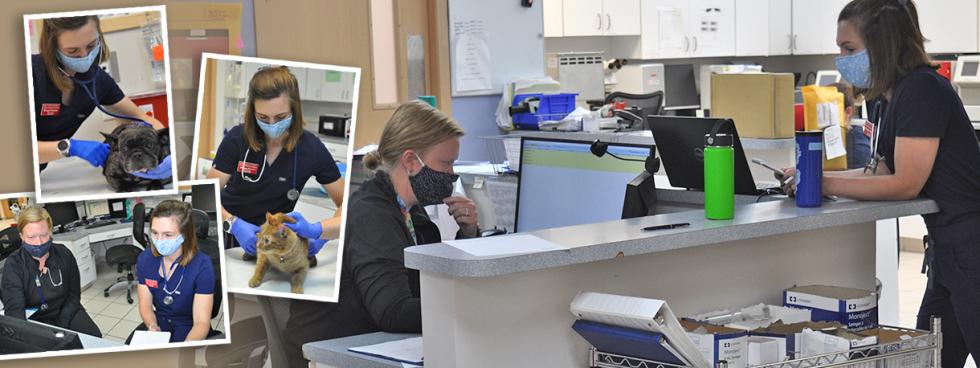
Change of Pace
One after another the patients come into Iowa Veterinary Specialties.
First in is an adult male cat with urinary tract issues. A few minutes later, a German Shephard puppy is admitted. They are soon joined by more and more patients.
It’s just another day at the Des Moines emergency and specialty hospital affiliated with the College of Veterinary Medicine.
But there’s something new at IVS this year. Fourth-year veterinary students at Iowa State are now taking a two-week training experience called a preceptorship at IVS.
Today that student is Morgan Pearson. Before Ravioli, Mango and the other patients arrive, Pearson is briefed on what to expect from Dr. Abbey Rupiper, a 2019 Iowa State DVM graduate and emergency clinician at IVS.
“We generally are slammed Monday mornings,” Rupiper said, “but you can expect to see a lot of patients every day.”
Not only does Pearson see a lot of patients, but the types of cases she saw at IVS is a good contrast to what fourth-year students will see while on a specialty rotation in Iowa State’s Hixson-Lied Small Animal Hospital. “Cases at IVS typically have multiple medical issues,” Pearson said. “That presents an amazing opportunity for integrating all of my medical training Iowa State has provided me.
“IVS has a quicker caseload than what I’m used to on my Iowa State rotations. It was initially daunting, but it was easy to adjust because of the outstanding veterinary technicians and clinicians I’ve been able to work with.”
Pearson and other fourth-year students at the IVS preceptorship split their time between emergency medicine and oncology. It was a set-up that intrigued Rachel Olesen to sign up.
“I was interested in both emergency and oncology veterinary medicine, as well as how high stress situations and poor prognosis situations were handled and discussed with owners,” Olesen said. “The most important thing I learned while I was there is that history and extensive physical exams of the patient are critical in evaluating emergency and oncology patients in order to properly assess their current status and future prognosis.”
A third fourth-year student who spent time at an IVS preceptorship was Conrad Cregor, who plans to go into emergency medicine after graduation. His career choice made the decision to go to IVS an easy one for him.
Cregor said he that while the Hixson-Lied Small Hospital has more than enough cases for each student to follow through on, he appreciated the contrast that IVS provided him.
“At IVS I was able to practice clinical skills, conduct physical exams and go through a case in detail from start to finish with a clinician,” he said. “Because I was the only student there, I had more opportunities than I could even take advantage of, to practice placing IV catheters, draw blood and perform physical exams.”
In addition to the high volume of cases, IVS also provides a fast-paced environment, one that took some getting used to.
“IVS has a high volume of cases,” Pearson said. “It’s possible to see an enormous variety of cases, ranging from exotic animal emergencies to oncology consultations and chemotherapy appointments.”
Olesen was at IVS before she took any rotation in the Hixson-Lied Small Animal Hospital. The time she spent there was essential, she said, in preparing her for what she could expect later on.
“Those two weeks prepared me better for cases in the small animal hospital because while I was at IVS I was able to evaluate patients, calculate dosages and listen to calls with owners,” she said. “Now I can confidently evaluate a patient, give a proper differential diagnosis and prescribe the correct medications for treatment.”
September 2020
